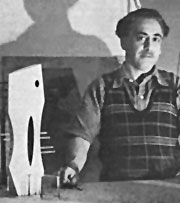
Carmelo Heriberto Alves was born in Rivera, Uruguay, on March 16, 1913. The Catalonian writer Emilio Sans, a friend of his family, introduced him to the Plastic Arts. In 1935 he met Joaquín Torres García during a conference at the Theosophist Society seat, and though he initially adopted his aesthetic guidelines, in 1936 he made his first non-orthogonal paintings, transgressing the traditional limits of the frame confinement. He exhibited those works at the Casa de España, Montevideo, within the framework of a demonstration supporting the Spanish Republic.
By the end of 1937 he settled in Buenos Aires where he frequented avant-guard artists and studied Philosophy and Literature in the University. In this city he shared his atelier with the Chilean artist Miguel Martínez, who introduced him to Gyula Kosice, at the time a teenager dedicated to leather goods.
In 1941 he took part in the founding of a bimonthly newspaper, El Universitario, where he published his political and aesthetic ideas. He was also a member of the editing group for Arturo magazine, issued only once in 1944.
In 1946, following aesthetic divergences, two organizations were formed: the Asociación Arte Concreto-Invención and the Madí Group. As a member of the latter, Arden Quin participated in the four exhibitions hosted by the Galería Van Riel and by the Escuela Libre de Artes Plásticas Altamira (Free School of Plastic Arts Altamira) during the last six months of that year. He also took part in the First International Madí Exhibition, organized at the Ateneo de Montevideo, Uruguay. He exhibited polygonal-framed works, movable and co-planar structures, object-pictures, and concave-convex works.
In 1948 he travelled to Paris, where he frequented Michel Seuphor, Marcelle Cahn, Auguste Herbin, Jean Arp, Georges Braque and Francis Picabia, among other vanguard artists. There he had various exhibitions, and participated in the Salon des Realités Nouvelles.
He returned to Argentina in 1954, and together with Aldo Pellegrini founded the Asociación Arte Nuevo (New Art Association) –integrated by artists of different non-figurative tendencies– that had its first exhibition at the Galería Van Riel in 1955.
Back to Paris he continued with his work, and during this period he introduced collage and découpage to his works, resources that he exclusively used until 1971, when he retook painting. In 1962 he created the Ailleurs magazine, and during that decade he participated in the Concrete Poetry movement.
Among his last exhibitions, his most outstanding ones were hosted by the Galerie Charley Chevalier, Paris (1973); the Galerie Quincampoix, Paris (1977); the Exhibition in Tribute to His Sixty Years, by the Espace Latin-Americain, Paris (1983); the Galeria Niza, Brescia (1986); the Galerie Down Town, Paris (1987); the Gallery El Patio, Bremen, Germany (1988), and the Foundation for Art and Technology, Madrid (1997). In 1998 the Ruth Benzacar Gallery in Buenos Aires organized an important monographic exhibition under the title Carmelo Arden Quin, Paintings and Objects 1945-1995.
He also participated in important collective exhibitions, such as Art in Latin America, The Modern Era (1820-1990), at the Hayward Gallery, London (1989); Argentina, Concrete Art Invention 1945, Madí Group 1946, at the Rachel Adler Gallery, New York (1990); Arte Madí Art, at the Centro de Arte Reina Sofía, Madrid (1997); and the Abstract Art from the Rio de la Plata, Buenos Aires and Montevideo 1933/53 exhibition, at The Americas Society of New York (2001).
He died in Paris on September 27th 2010.